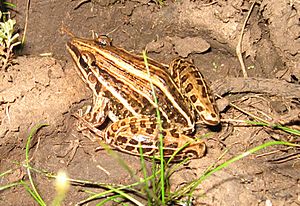Leptodactylus gracilis facts for kids
Quick facts for kids Graceful Foam Frog |
|
|---|---|
 |
|
| Conservation status | |
| Scientific classification |
The Leptodactylus gracilis, also known as the Graceful Foam Frog, is a type of frog. It belongs to a large family of frogs called Leptodactylidae. These frogs are found in several countries in South America.
This frog lives in many different places. You can find it in Argentina, Bolivia, Brazil, Paraguay, and Uruguay. It likes areas with lots of plants and water.
Contents
What Does It Look Like?
The Graceful Foam Frog is a medium-sized frog. It has a body that helps it blend in with its surroundings. Its skin can be different shades of brown or grey. This coloring helps it hide from predators. It often has darker spots or stripes on its back and legs. These markings help it camouflage among leaves and soil.
Where Does It Live?
This frog is very adaptable. It can live in many kinds of places. Its natural habitats include moist shrublands. It also lives in temperate grasslands. You can find it in dry lowland grasslands too. Sometimes, it lives in grasslands that get wet or flooded during certain seasons.
The Graceful Foam Frog also likes areas with water. It can be found near temporary freshwater marshes. These are wetlands that might dry up sometimes. What's interesting is that this frog can also live near humans. It is often seen in pasturelands and rural gardens. It can even be found in urban areas. This shows how well it can adjust to different environments.
What Does It Eat?
Like most frogs, the Graceful Foam Frog is a carnivore. This means it eats other animals. It mainly eats small invertebrates. These include insects like beetles, flys, and ants. It also eats spiders and other small creatures. The frog waits patiently for its prey. Then, it uses its long, sticky tongue to catch its meal.
Life Cycle and Reproduction
Frogs have a fascinating life cycle. The Graceful Foam Frog lays its eggs in a special way. Many frogs in the Leptodactylus family build foam nests. The female frog lays her eggs in a foamy mass. This foam protects the eggs from drying out. It also hides them from predators.
The foam nest is often built near water. Sometimes, it's even built on land. The eggs hatch into tadpoles. These tadpoles then develop in the water. They slowly grow legs and lose their tails. This process is called metamorphosis. Eventually, they become young frogs. These young frogs then leave the water to live on land.
Conservation Status
The Graceful Foam Frog is listed as "Least Concern" (LC) by the IUCN. This means that its population is stable. It is not currently facing a high risk of extinction. Its ability to live in many different habitats helps it survive. However, it's always important to protect natural areas. This helps all wildlife, including frogs, thrive.
See also
 In Spanish: Rana rayada para niños
In Spanish: Rana rayada para niños


